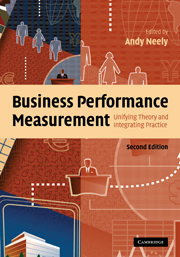Book contents
- Frontmatter
- Contents
- List of figures
- List of tables
- List of boxes
- List of contributors
- Introduction
- Part I Performance measurement – functional analyses and theoretical foundations
- Part II Performance measurement – frameworks and methodologies
- Part III Performance measurement – practicalities and challenges
- 11 Choosing marketing dashboard metrics
- 12 Risk in performance measurement
- 13 Measuring knowledge work
- 14 Measuring innovation performance
- 15 Context-based measurement
- Part IV Performance measurement in public services
- Part V Performance measurement – emerging issues and enduring questions
- Index
- References
13 - Measuring knowledge work
Published online by Cambridge University Press: 22 September 2009
- Frontmatter
- Contents
- List of figures
- List of tables
- List of boxes
- List of contributors
- Introduction
- Part I Performance measurement – functional analyses and theoretical foundations
- Part II Performance measurement – frameworks and methodologies
- Part III Performance measurement – practicalities and challenges
- 11 Choosing marketing dashboard metrics
- 12 Risk in performance measurement
- 13 Measuring knowledge work
- 14 Measuring innovation performance
- 15 Context-based measurement
- Part IV Performance measurement in public services
- Part V Performance measurement – emerging issues and enduring questions
- Index
- References
Summary
Introduction
The explosive growth of the information-related and science-based sectors of industrialized economies has seen concomitant growth in the demand for products and services with potential to help organizations apply what they know more profitably. There are entirely new occupational categories – combinatorial chemist, network manager, software engineer, to name just a few – that produce economic value mostly by creating and manipulating symbols. Even in traditional occupations, ways of working have come to depend on intellectual activity more than physical activity. Factory workers invent and share process improvement ideas; salespeople develop novel ways to use the Web to reach or retain customers.
As the nature of work has changed, the relationship between an organization's measured resources and its market success has become tenuous. Factors that contribute substantially to a firm's market success largely elude traditional means of quantification. Unlike materials and equipment, core competencies comprised of the distinctive abilities of employees and teams are not easily captured on balance sheets. This fact not only makes valuation of individual firms harder, it also complicates traditional analyses for allocating resources, improving processes, and compensating employees.
Existing notions of performance measurement and organizational control meet with substantial challenges in knowledge work settings. In this chapter, we identify distinctive characteristics of “knowledge work” that impact our ability to measure it, and briefly discuss the research challenges and practical implications associated with those characteristics. Conceptually, these characteristics can be placed in three categories.
First, knowledge work is less observable than physical work.
Information
- Type
- Chapter
- Information
- Business Performance MeasurementUnifying Theory and Integrating Practice, pp. 279 - 303Publisher: Cambridge University PressPrint publication year: 2007
References
Accessibility standard: Unknown
Why this information is here
This section outlines the accessibility features of this content - including support for screen readers, full keyboard navigation and high-contrast display options. This may not be relevant for you.Accessibility Information
- 1
- Cited by
